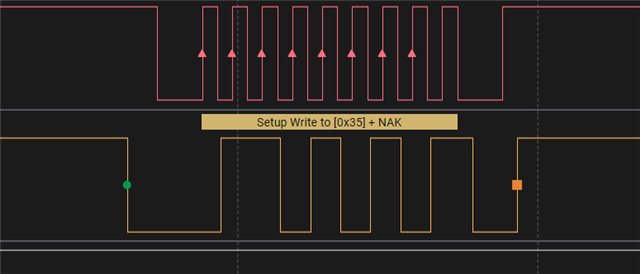Hello, I have a sensor from ST-Electronics that uses the I2C protocol to communicate with the NRF52840. The sensor has an 8-bit address, specifically 0xB5, which is outside the range of 7-bit addressing mode used by the NRF driver. I have been working on this for three days with no success. I have tried using bit shift operations but it did not work. Is there any way to communicate with the sensor using its 8-bit addressing mode?
Application initialilly read the "WHO_I_AM" address
//This HAL .c file for nrf52 pointer function
/** I2C Device Address 8 bit format **/
//#define STHS34PF80_I2C_ADD 0xB5U
int STHS34PF80_I2C_ADD = (0xB5 >> 1);
/* Device initialization */
volatile bool tx_m_xfer_done = false;
volatile bool rx_m_xfer_done = false;
void st_transaction_handler(nrf_drv_twi_evt_t const * p_event, void * p_context)
{
switch (p_event->type)
{
case NRF_DRV_TWI_EVT_DONE:
if (p_event->xfer_desc.type == NRF_DRV_TWI_XFER_TX)
{
tx_m_xfer_done = true;
}
if (p_event->xfer_desc.type == NRF_DRV_TWI_XFER_RX)
{
rx_m_xfer_done = true;
}
break;
default:
break;
}
}
void twi_init (void)
{
ret_code_t err_code;
const nrf_drv_twi_config_t twi_config = {
.scl = ST_MOTION_SCK_LINE,
.sda = ST_MOTION_SDK_LINE,
.frequency = NRF_DRV_TWI_FREQ_100K,
.interrupt_priority = 0
};
err_code = nrf_drv_twi_init(&SENSOR_BUS, &twi_config, st_transaction_handler, NULL);
APP_ERROR_CHECK(err_code);
nrf_drv_twi_enable(&SENSOR_BUS);
}
void platform_delay(uint32_t ms)
{
nrf_delay_ms(ms);
}
int32_t platform_write(void *handle, uint8_t reg, uint8_t *bufp,uint16_t len)
{
ret_code_t res;
res = nrf_drv_twi_tx(handle,STHS34PF80_I2C_ADD, ®, 1,false);
/*Error Implementation remaining and should be Implemented*/
res = nrf_drv_twi_rx(handle,STHS34PF80_I2C_ADD, bufp, len);
}
int32_t platform_read(void *handle, uint8_t reg, uint8_t *bufp,uint16_t len)
{
ret_code_t res;
res = nrf_drv_twi_tx(handle,STHS34PF80_I2C_ADD,®,1,false);
APP_ERROR_CHECK(res);
while (tx_m_xfer_done == false);
res = nrf_drv_twi_rx(handle,STHS34PF80_I2C_ADD, bufp, len);
APP_ERROR_CHECK(res);
while (rx_m_xfer_done == false);
tx_m_xfer_done = false;
rx_m_xfer_done = false;
}

When no right shift operation is used.
